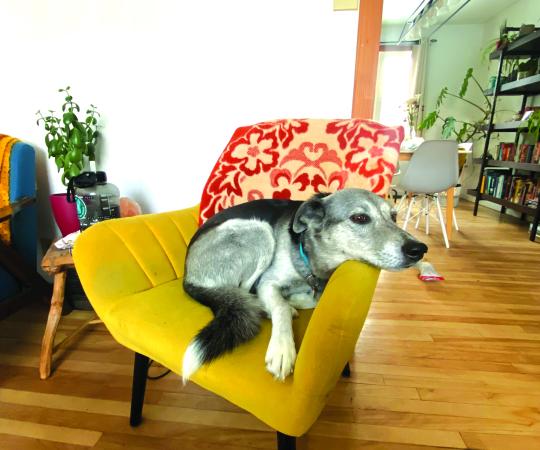A centuries-old practice, tanning is a physically demanding process that involves removing the animal’s flesh and hair, followed by many rounds of stretching, pounding, and scraping. Melaw Nakehk’o also soaks hides repeatedly in fermented moose or caribou brain to soften their fibres before finally smoking them over the fire. Then she painstakingly stitches row upon row of colourful beads.
The hides of moose or caribou have a variety of traditional uses in Dene culture, but in the Yellowknife artist’s hands, they assume new life as powerful sculptures. Shapeshift, Charm, and Liminal are three pieces made with caribou hide, red and turquoise beads, sinew, embroidery, beaver fur, and wire. The series is about shape-shifting, the magical ability of some humans and creatures to change physical form. Many of the Dene legends and origin stories Nahkehk’o grew up hearing contain human-caribou mutations. “I have dreamed of these shapes. They feel like self-portraits,” she says. “I often feel like becoming a caribou, following the herd into a brilliant sunset. I have been sewing these moments, imagining my transformation.”
Nakehk’o, who’s Dehcho and Denesuline Dene and originally from Fort Simpson, is passionate about hide tanning and has worked to revitalize the practice, learning as much as she can from her Elders. In 2012, she helped found Dene Nahjo, a non-profit organization focussed on social and environmental justice for northern Indigenous peoples. That same year, she received a Minister’s Cultural Award for sharing traditional knowledge. Since then, under her guidance and influence, interest in hide tanning has grown in the territory and beyond. She even taught it in Toronto’s trendy West End.
Through her art, Nahkehk’o attempts to build a new visual language to describe the Dene relationship with caribou. Grimm’s fairy tales and the stories by Hans Christian Anderson are written down and illustrated, she points out, but Dene stories are passed down orally. “When hearing them told,” she says, “it was up to me, in my imagination, to conjure what shape-shifting looked like.”
Her conjured visions, it turns out, have a totemic feel and an eerie power. Elongated arms grow from antlers. Horns morph into hands or snake-like tails. There are dangling, dismembered fingers—each one rimmed in red beads to simulate blood. In Nahkehk’o’s imagination, shape-shifting is beautiful, violent, and endlessly fascinating. But there are tender elements in the sculptures, too. The paired hands, for example, are purposefully small, invoking the vulnerability and sweetness of childhood. The sculptures also smell wonderful, owing to the rich smoke she repeatedly bathed them in during the tanning process.
This past summer, she showed her hide sculptures at The Northern Gothic exhibition on Prince Edward Island and at the Contemporary Native Art Biennale in Montreal. Still, Nakehk’o considers the sculptures to be mere prototypes. She plans to develop the series further, probing the limits of her imaginative powers to give visual forms to other Dene plot lines and protagonists. In a sense, Nakehk’o’s art is a full circle. First, the caribou dies and is harvested. Then, Nakehk’o tans the hide. Finally, the hide radiates a new life, again, as art—and a way to support a dynamic future for Dene stories.
Beyond cultural revitalization, Nakehk’o enjoys working with hides because of their supple, malleable texture and the way they lend themselves to her artistic vision. “The field is wide open, visually,” she says. “The possibilities are endless.”—Sarah Swan










